This is the second in my three-part series geeking out on the wonderfulness of writer Doug Moench and artist Paul Gulacy’s 1970s run on the Marvel comic book Master of Kung Fu – abbreviated MOKF. I suggest starting with the first article which is here. While I pride myself on explaining various stuff in a way that the average uninitiated reader can comprehend… this post feels a bit impenetrable for the non-comics-fan. For true enjoyment, you, dear reader, might need some exposure to Alan Moore’s work, especially Watchmen – the comic, not the movie.
– – – – –
While Gulacy’s pan sequences are great, he also, less frequently, does another multi-panel sequence story-telling trick that’s, in a way, the opposite. This sequence, which I also don’t have a really good name for, features a series of panels depicting the exact same location – cinematically, but where the action progresses over time. It’s almost as if a stationary camera has been left running, and each panel is a snapshot from that camera. So, for lack of a better term, I’ll refer to it as a fixed-camera sequence.
Here’s an example, from January 1977:
All four of these panels are from the exact same camera angle, as the scene changes over time. This is confirmed by the unchanged vertical rock wall on the left side of each. It’s a good steady progression from solitary and composed to busy and crowded. The fixed-camera sequence seems fairly direct – it’s not flashy, show-offy… it serves the progression of the story, more than drawing attention to its own artifice.
About ten years later (1986-87), Alan Moore and Dave Gibbons use this sort of fixed-camera progression in many many places throughout Watchmen. The first Watchmen examples I found are chapter 1, page 12, panels 3-6, then chapter 1, page 15, panels 7-9 (below)… and plenty more.
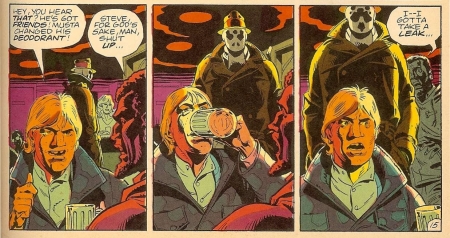
Three panel Fixed-Camera Sequence from Watchmen ch 1 p 15, writing by Alan Moore, art by Dave Gibbons
In these three panels, the central character is seated “facing the camera.” The costumed hero Rorschach approaches the camera, and the drinking buddy gets scared and runs off.
From here down, I will keep making comparisons to Alan Moore, and especially Watchmen. I am a huge Alan Moore fan. I don’t think that Moore and Gibbons stole or swiped MOKF stuff in any bad or mean way. All great art builds on the rich legacies of what has come before. I think that Moore and Gibbons just continued to hone a story-telling technique that Moench and Gulacy were pioneering and practicing earlier… and there may well be versions of these tricks that precede MOKF, too, though I am not aware of any right now. Gulacy uses the fixed-camera sequence very sparingly… and in the hands of Moore and Gibbons, it sings… but without really drawing attention to itself.
Here’s another Moench-Gulacy MOKF sequence (from May 1976) that when I see today, also reminds me of Watchmen:
Almost anyone who’s read Watchmen will recognize the 9-panel page layout… ubiquitous throughout Watchmen. The sort of checkerboard alternation between two scenes happening at different times/places is also very common throughout Watchmen (and other Moore work: Swamp Thing, Promethea, etc. etc.).
(Credit where credit due: I acknowledge that I was made aware of this next point from reading commentary on Alan Moore’s 1963 comic, for example 1963 annotations here.)
This sort of smooth panel-to-panel transition from one setting to another was made more difficult by the 1960s Marvel comics tendency to nearly always spell out “MEANWHILE” (or “LATER AT THE BAXTER BUILDING” or something along those lines) between transitions… despite the transitions generally being pretty obvious due to other changes (scenery, cast, etc.)
In Moench and Gulacy’s transitions on the above two pages, the cues to the different settings are accentuated. One sequence is framed with rounded corners, the other with right angles. One sequence has a black background, the other a colorful background… so it’s not at all difficult to follow without the MEANWHILEs. Moore and Gibbons utilize borders and fonts and color cues to make differentiation even easier to read.
What Moore does expertly throughout his oeuvre (and Moench and Gulacy just barely explore) is the intertwining or converging of two scenes by ending one on a word or phrase that leads into the other. I think that that device is almost trademark Alan Moore. He does it expertly and almost never misses an opportunity for that sort of transition. Gulacy and Moench do it barely, loosely in the above sequence, for example in page 3 panel 1, Shang-Chi is talking about Smith’s false claim, then in panel two he opens talking about deceit (maybe that’s a stretch.)
For comparison, here’s a page from Watchmen – it’s not an important page or a great page, but it shows a lot of the storytelling tricks that I’ve been enjoying in MOKF:
I don’t want to write all that much about Watchmen. In case you, dear reader, are completely unfamiliar with it… this page is part of a subplot that takes place at a newsstand where a kid is reading a pirate comic book. Panels 1-3, 5, 7 and 9 depict the newsstand. Panels 4, 6, and 8 are the panels of the pirate comic book. The narration from the pirate comic book appears in every panel; it’s differentiated from other speech balloon text because it includes a border that has scrolling paper edges, and the font is slightly different.
So… here are some things that relate to what I’ve been writing about MOKF:
- Panels 1-3 are a pan sequence, which I wrote about at length here.
- The overall page has the same 9-panel alternating checkerboard as the MOKF No. 4o page 2 above (it’s actually very, very similar, because that page also uses the initial three panels to establish the setting, then begins alternation at panel 4.)
- The word MEANWHILE doesn’t appear anywhere on the page. It may not be clear to a blog reader who is seeing this out-of-context page for the first time, but by the time a reader gets this far into Watchmen, all the cues/transitions are all visually obvious, from subject matter and borders.
- Every panel (with the exception of maybe panel 8) includes that trademark Alan Moore convergence transition where the wording from one scene (the newsstand) relates to the other scene (the pirate comic book) either visually or in text or both. For example, in panel 6, the newsstand owner is talking about Rorschach, a costumed superhero, who had patronized the newsstand, though while in his incognito identity. The owner says “…lotta stuff happens under the waterline” and this corresponds to the image: a pirate comic book panel depicting the underside of the raft the narrator is riding.
There’s a lot more going on, even on just this page… I bring it up only to shows how tools are used similarly, but with great idiosyncratic variation, by different writers and artists. And it also shows that what was a bit experimental in mid-1970s comics has been mastered, re-vamped and furthered by Alan Moore in the late-1980s.
Here’s another Moench/Gulacy MOKF sequence that also resembles an Alan Moore convergence transition:
This has the alternating scenes, with color differentiation. Panels 2, 4, 6, etc. are black background. Panels 3, 5, 7, etc. have a green background. The settings are also differentiated by the presence and absence of dialog. The even panels also employ sort of fixed-camera sequence that I wrote about above.
The Alan-Moore-esque transition is panels 13-14-15. When the name of the enemy is revealed to be “known as… cat” the Siamese cat fills the adjacent panels.
Lastly, there’s a whole issue where each page features a Moore-esque transition. It’s MOKF No. 42, titled The Clock of Shattered Time… and it’s better read than described. Pretty much the entire issue runs along two parallel tracks. The sort of “earlier” story is the lead-up investigating a clue toward a mole operating in the British spy agency, who has set a bomb attached to a clock (imbuing that title with a few different meanings). That “early” story will lead to the “later” story, which is basically a big fight between Shang-Chi and a villain who goes by the name Shockwave. So… the fight between Shang-Chi and Shockwave, the “later” story, occurs in snippets throughout the issue… and when it finally begins at the end of the “earlier” story, the reader already knows how it has turned out. It’s all very clever, very simultaneous… and you won’t quite get that from my meager description.
Here’s a page from The Clock of Shattered Time:
Panels 1, 2, 4 and 5 take place in the earlier story. Panel 3 (those are Shockwave’s yellow legs) takes place in the later story. The Alan Moore type transition is that when, in panel 2, Smith says “Oriental Expediters”, that pertains to the Oriental Expediters sign in the background of panel 3. These sorts of flash-forwards then flash-backs punctuate the entire issue.
That’s all for part two. For part 3, I plan to write about the award-winning Moench-Gulacy story arc that runs from MOKF No. 45 through No. 50. Update: part 3 posted here.
Tags: Alan_Moore, comics, Doug_Moench, Master_of_Kung_Fu, Paul_Gulacy, Shang-Chi
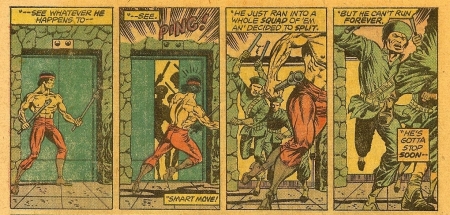
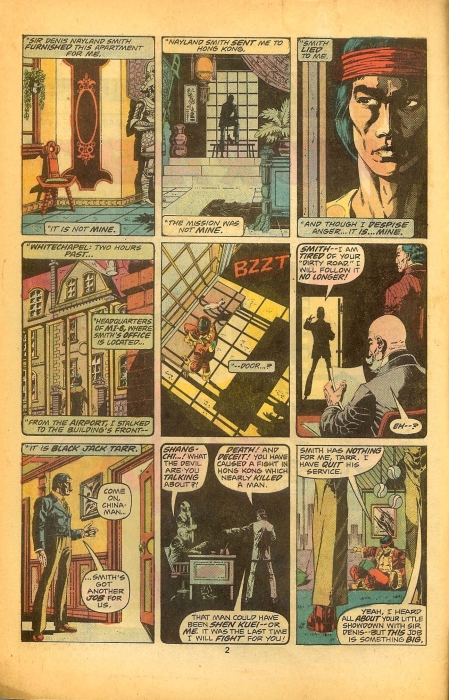
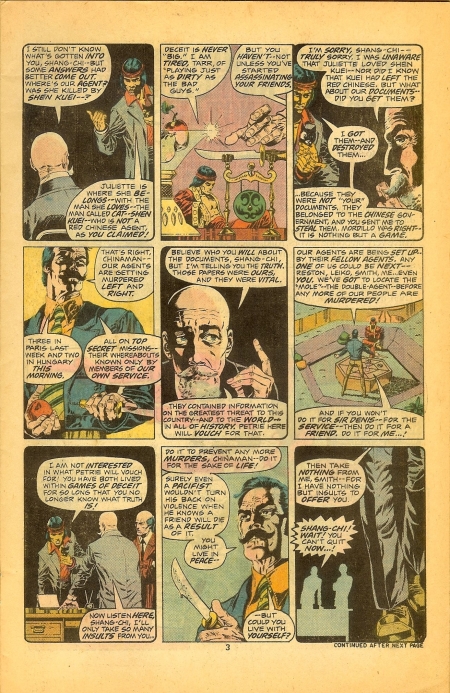
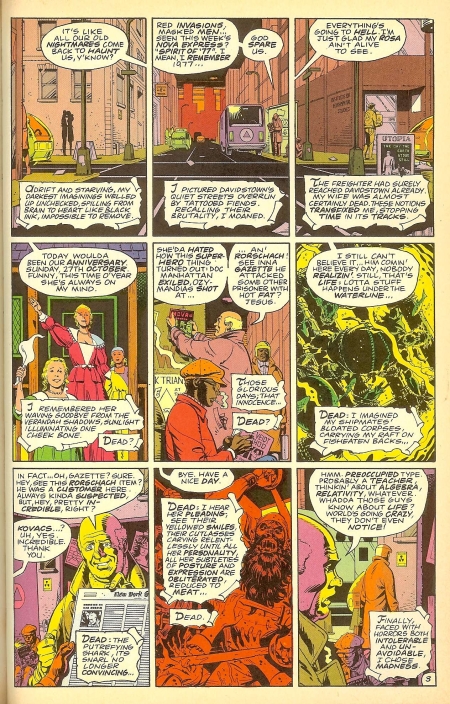
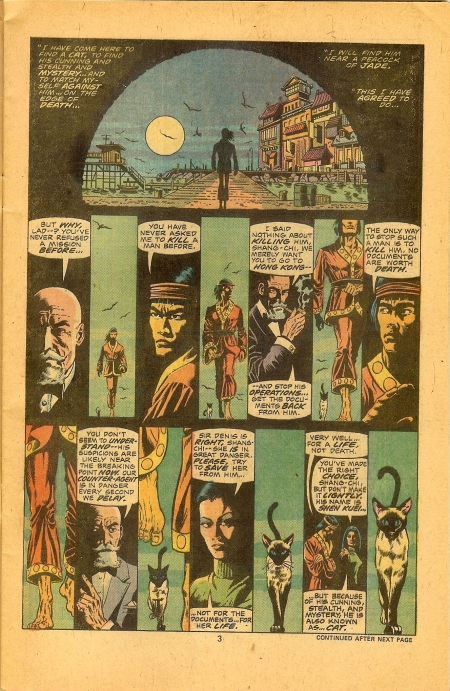
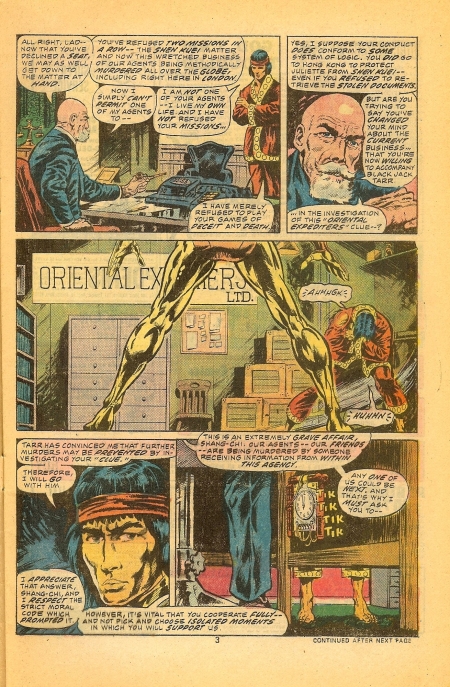
22 January 2013 at 3:58pm |
[…] don’t get this, here’s the excerpt form the graphic novel and the explanation from The periodic fable […]
26 January 2015 at 12:10pm |
“the 1960s Marvel comics tendency to nearly always spell out “MEANWHILE” — in 1975 i was an italian child in the US learning english from scratch on my own by reading spiderman comics and for a very brief time i thought “meanwhile” was a place where spiderman went or hung out, like “bronx” or something. haha!!!
26 January 2015 at 12:17pm |
This made me smile!
26 January 2015 at 12:12pm |
“for example in page 3 panel 1, Shang-Chi is talking about Smith’s false claim, then in panel two he opens talking about deceit (maybe that’s a stretch.)” bee ewe tee full